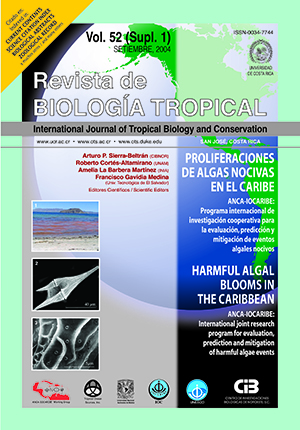Resumen
En el mes de noviembre de 2001, se aisló de una marea roja cerca de la Isla San Lucas, las diatomeas Pseudo-Nitzschia pungens f. pungens seguida por Skeletonema costatum, Chaetoceros lorenzianus y en menor concentración Thalassiosira spp. las cuales fueron caracterizadas por microscopía electrónica de rastreo y transmisión, siendo esta la primera vez que se describe la presencia de estas especies produciendo proliferaciones en Costa Rica. Actualmente existe un aumento en el reporte de mareas rojas donde predominan las diatomeas, y los conteos celulares indican el aumento en el número de las especies conocidas como Pseudo-nitzschia pungens f. multiseries. A estas se les atribuye la producción del ácido domóico, un aminoácido de bajo peso molecular. Las intoxicaciones amnésicas por mariscos (IAM) que afectan a los humanos, se producen por la ingesta de mariscos contaminados con este ácido. En Costa Rica, hasta la fecha, solo se han reportado casos de intoxicación paralítica por mariscos contaminados por los dinoflagelados Pyrodinium bahamense var. compressum y Gymnodinium catenatum, sin embargo existe la posibilidad de producirse intoxicaciones humanas por la ingesta de mariscos y peces contaminados con toxinas amnésicas las cuales son hidrosolubles y termoestables. Debe entonces considerarse el peligro potencial de aparición de casos de intoxicaciones amnésicas y se sugiere la inclusión de estas especies en los programas de monitoreo permanente para tomar las medidas preventivas de salud pública.Citas
Glibert, P.M. & G. Pitcher. 2001. Global Ecology and Oceanography of harmful algal blooms. Science Plan. An International Programme sponsored by the Scientific Committee on Oceanic Research (SCOR) and the Intergovernmental Oceanographic Commission (UNESCO). 86 p.
Hallegraeff, G.M., D.M. Anderson & A.D. Cembella. 1995. Manual of Harmful Marine Microalgae. Intergovernmental Oceanographic Commission (UNESCO). 551 p.
Hallegraeff, G.M., S. Blackburn, C. Bolch & R. Lewis. 2001. Harmful Algal Blooms 2000. Proceedings of the Ninth International Conference on Harmful Algae Blooms, Hobart, Australia, 7-11 February 2000. Intergovernmental Oceanographic Commission (UNESCO). 518 p.
Hargraves, P. & R. Víquez. 1981. The dinoflagellate red tide in Golfo de Nicoya, Costa Rica. Rev. Biol. Trop. 29: 31-38.
Horner, R., L. Hanson, C. Hatfield & J. Newton. Domoic Acid in Hood Canal, Washington, USA. In T. Yasumoto, Y. Oshima & Y. Fukuyo. 1996. Harmful and Toxic Algal Blooms. Proccedings of the Seventh International Conference on Toxic Phytoplankton Sendai, Japan, 12-16 July 1995, UNESCO.
Mata L., G. Abarca, L. Marranghello & R. Víquez. 1990. Intoxicación paralítica por mariscos (IPM) por Spondylus calcifer contaminado con Pyrodinium bahamense, Costa Rica. Rev. Biol. Trop. 38: 129-136.
Negri, R. & D. Inza. 1998. Some potentially toxic species of Pseudo-Nitzschia in the Argentine sea (35º-39º S). Harmful Algae, Xunta de Galicia and Intergovernmental Oceanographic Commision of UNESCO 1998. pp. 84-85.
Ochoa, J.I., A.P. Sierra-Beltran, G. Olaiz-Fernández & L.M. Del Villar-Ponce. 1998. Should mollusk toxicity in Mexico be considered a public health issue? J. Shellf. Res. 17(5): 1671-1673.
OPS 1997. Manual para el Control de las Enfermedades Transmisibles. Organización Panamericana de la Salud.
Smayda, T.J. & Y. Shimizu. 1991. Toxic Phytoplankton Blooms in the Sea. Fifth International Conference on Toxic Marine Phytoplankton, Newport, Rhode Island.
Tomas, C.R. (ed.). 1997. Identifying marine phytoplankton. Academic, New York. 858 p.
Trainer, V., J. Wekell, R. Horner, C. Hatfield & J. Stein. 1998. Domoic acid production by Pseudo-Nitzschia pungens, pp. 337-339. In B. Reguera, J. Blanco, M.L. Fernández & T. Wyatt. 1997 Harmful Algae, VIII International Conference, Vigo 1997. Xunta de Galicia and Intergovernmental Oceanographic Commision of UNESCO.
Víquez, R. & P. Hargraves. 1995. Annual cycle of potentially harmful dinoflagellates in the Golfo de Nicoya, Costa Rica. Bull. Mar. Sci. 57(2): 467-475.
Yasumoto, T., Y. Oshima & Y. Fukuyo. 1996. Harmful and Toxic Algal Blooms. Intergovernmental Oceanographic Commission, UNESCO. Proceedings of the Seventh International Conference on Toxic Phytoplankton. 586 p.
##plugins.facebook.comentarios##

Esta obra está bajo una licencia internacional Creative Commons Atribución 4.0.
Derechos de autor 2004 Revista de Biología Tropical


